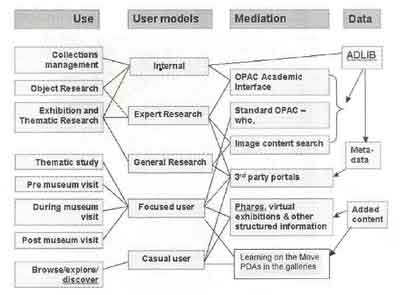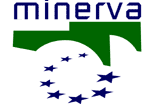| |
Italian Semester of Presidency of the European Union
EUROPEAN CONFERENCE OF MINERVA
Quality for cultural Web sites
Online Cultural Heritage for Research, Education
and Cultural Tourism Communities
Parma, 20-21 November 2003, Auditorium Paganini
Margaret Greeves
(Assistant Director, Central Services Fitzwilliam Museum)
"IPR challenges for the Museum: a case study"
I am delighted to have this opportunity to present some of the
work of the Fitzwilliam Museum as a case study to this Minerva conference,
to earth our discussions in the real experience of an institution
whose twin purposes are preserving the collections in its care and
making them freely accessible for public education and enjoyment.
Throughout, we will be talking about editorially reliable, high
quality content, particularly images, and its delivery over the
Internet.
Our case study will illustrate the following statements from the
introduction to the Minerva programme, "Cultural heritage institutions
are in a key position to deliver the kind of unique learning resources
that are needed at all educational levels…[Such activity] challenges
the cultural institutions at their very core… Digitisation
is an expensive and technically complex enterprise in the long term
and this should not be underestimated…it requires noteworthy
investments and a strong commitment on the part of the individual
organisations that are depositories…A further commitment is
required to reduce digitisation costs [ ] and to develop new business
models. Among the principal challenges posed…is the conservation
of digital resources in the long term".
Underlying all that I shall say in this paper will be the conundrum:
how do we fund the activities that contribute to building the electronic
product? and the challenge, what innovative partnerships might be
developed between the cultural content providers and the commercial
publisher or other funding partner to sustain these developments?
The Fitzwilliam Museum is the art museum of the University of Cambridge,
containing approximately half a million objects in the care of five
curatorial departments - Antiquities, Applied Arts, Coins and Medals,
Manuscripts and Printed Books and Paintings, Drawings and Prints.
All the collections are "designated" under a scheme which
identifies 50 collections in the UK of very significant national
importance. Under one roof we have museum collections, archives
and two libraries, spanning civilisations and millennia.
Until five years ago our use of images was conservatively traditional.
Our photographers took (and still take) colour transparencies for
publication in scholarly catalogues, general guides, exhibition
guides, teaching materials and for the illustration of research
by our own staff, members of the University of Cambridge and scholars
scattered across the world. Duplicate transparencies are deposited
with the Bridgeman Art Library and photographs and reproduction
rights are also sold directly by the Museum. Other photographic
activities are associated with conservation for condition reporting
and for
security purposes. The Fitzwilliam Museum Enterprises Company develops
products based on the collections using the transparencies - mainly
stationery goods - and generates revenue for the benefit of the
Museum. Again, unsurprisingly, we use images for public relations,
profile building and publicity purposes, to market the Museum and
its services, directly and through press and media coverage. Of
course, I do not need to tell this audience that the protection
of our copyright in our images is fundamental in this traditional
picture.
We did, however, give permission for our images to be included
in scholarly websites such as the Blake Archive and the Rossetti
Archive. These give access at two levels so that, using high resolution
images, art historians can make comparisons of different versions
of in vivo publications of the work of these two artists. We spent
much time negotiating watermark protection of the images, the inclusion
of statements of our copyright and direction back to the Fitzwilliam
for those who tried to print off images from the website.
The introduction at the Fitzwilliam Museum of an electronic Collections
Information Management System in 1999 rapidly drove a culture change.
With a grant form Resource, the Council for Museums, Archives and
Libraries to assist the Museum to address backlogs in documentation,
and following two years of careful planning, we introduced a collections
management database using Adlib software, and have been building
it up ever since, adding a curatorial department at a time and seeking
carefully to ensure consistency in the application of standards
and terminology.
Within 18 months of embarking on this project, however, the emphasis
shifted from information management to information sharing. The
drivers were technological - the ease of introducing a web interface
- and strategic. The expectations of users of museums such of ours,
the stimulation of government funding and the University environment
in which we work reinforced a new emphasis on access. In a very
short space of time we were driven to look up from our dedicated
inputting to create object records to consider who would use the
information, and how. The first step was intranet access, which
allowed the curatorial departments to look at one another's records
and non-expert staff members to share the information. This demonstrated
an unexpected ease of use - and usefulness. We then took a leap
and went public; we offered the information to our peers in other
museums and were surprised by their very positive response.
In other words, within less than two years of the start of our
project its purpose needed to be radically revised. Its new scope
was stimulating, exciting - and challenging. We found that our attention
to the application of standards, consideration of terminology and
the consistent use of fields across different types of materials
was increased. As accessibility became more important we sought
to define our several audiences, including those with disabilities
and special needs, and are currently evaluating the usability of
our website, the key interface to the information.
We have been rewarded with funding to collaborate in pilot projects,
as a content provider. We are preparing 100,000 records for harvesting
as metadata through the Open Archives Initiative (OAI). It will
be made available to the Higher Education environment through the
Arts and Humanities Data Service (AHDS) portal and the Archaeological
Data Service (ADS). It will also be harvested by 24-Hour Museum
which currently provides information on Museums' events and exhibitions
but is building a portal that will give users a taste of the objects
in the collections through thumbnail images and associated brief
records. In both projects we value the opportunity to collaborate
with partner museums and to benefit from the technological input
of the data providers.
Both projects have stimulated the Fitzwilliam Museum team to find
new routines - applying more automation to data cleansing, speeding
up the capture of images (see our Coins collections information
via www.fizmuseum.cam.ac.uk).
Interoperability throws up issues of standards, classification,
terminology, and for us, of consistency across different object
and collection types. The funding support for all of the work on
the database and allied projects described thus far is £500,000.
We have become more adventurous still and have developed a strategy
that examines opportunities for re-purposing knowledge for delivery
to different audiences in a variety of media and strives to take
forward their delivery simultaneously. We are nearing the completion
of Pharos, a web-accessible
structured database of information which links 300 key objects across
the Museum's departments. Many criteria were applied to the choice
of objects all of which are rich in their potential to offer connections
that empower the visitor to explore a variety of pathways, chronological
and thematic. The development of the content and the design has
taken three years and includes interactive demonstrations of techniques
of manufacture such as the creation of a fifteenth century, gold-ground
panel painting and the complex process of lost wax bronze casting.
The project was achieved for £100,000 but threw up pressing
IPR problems.
Now we are working on re-purposing the Pharos material and adding
to it in order to offer information within the galleries via handheld
computers. We will offer audio in several languages and for sight-impaired
visitors. We will use floorplans to orient visitors and diagrams
to locate works in their original context or reunite part works.
We also intend to extend our methods and materials videos to show
how coins were struck, Japanese wood blocks were printed, medieval
manuscripts illuminated and pots thrown.
Creative ideas abound but as our projects grow and become increasingly
complex, so the challenges increase. Our commitment to quality of
content and quality of access must be maintained but greater access
carries greater exposure to risk. Greater exposure of images on
the Web means greater loss of control, and this, in turn, will diminish
their value for exploitation in products to generate income. And
all this activity requires a level of investment that in our case
means constant searching for, applying for and obtaining grant support.
This diagram summarises how we see our project:

At the Fitzwilliam, on a very small scale, we have collected evidence
that shows clearly that users prefer images and that they provide
important information about cultural objects. Images enrich the
information and extend the creative uses to which it can be put.
The inclusion of images in publicity available electronic information
does cause us many copyright concerns and cost, however. So the
questions for us is how can we broker agreements with rights holders
for the use of images in educational materials at no cost? and how
can we protect our images from theft and misuse by others? How may
we find funding partners to share development costs who are willing
to do this with a light touch that will allow, indeed encourage
us to continue to experiment. In order to continue the development,
to sustain the products and to archive them securely, we would also
like to discover new models for cultural organisations to fund their
electronic access activities. Currently we seem to have four business
models: a) commercial sponsorship such as that by British Telecom
at Tate, b) the academic model that allows access at various levels
by means of a subscription (that is costly to collect), c) one which
relies on advertising and offers free access to the site but may
compromise the integrity of the institution and d) the current unsustainable
model where the institution and educational/national funders support
the development on a project by project basis.
In this rapidly developing area, cultural organisations with content
to provide need to test the market and need to find new funding
models. Is there a role for e-commerce? Should we rely on Europe?
|
|
|



